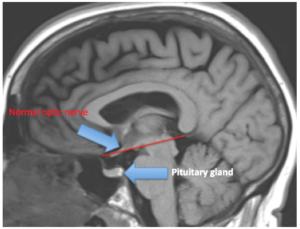A 21-year-old British man was recently featured in the news having a brain mass causing blurry vision. According to reports, Harry Mockett of Northampton noticed he was having trouble watching television and tried multiple pairs of glasses without resolution. Eventually, an eye doctor noticed changes in the back of his eye, potentially indicating increased pressure from a brain mass. A brain scan showed a craniopharyngioma.
In British, that’s cra·nio·pha·ryn·gi·o·ma.
In English, that’s cra·nio·pha·ryn·gi·o·ma.
“I had no other symptoms other than my vision seeming to get blurrier, and I thought I just needed glasses – I had no idea I had a brain tumor”.
“I really thought I was absolutely fine, I felt perfectly healthy – I even went out to a gig with my mates two days before the MRI scan”.
He underwent surgery and reportedly has done well. The details of Mr. Mockett’s surgery are unknown.
Craniopharyngiomas are benign tumors that form during brain development and before birth. Tissue near the pituitary gland that’s supposed to dissolve as the brain forms persists and the remnant tissue can grow. It’s not cancer and some may argue it’s not even a real tumor since it’s just retained tissue. But untreated craniopharyngiomas can enlarge and cause serious problems due to pressure on the brain and eye nerves. This can lead to blindness or even death.
Many craniopharyngiomas require surgery and near-complete resection is achievable. Sometimes part of the tumor can be removed using a small incision and a camera called an endoscope. However, a larger incision, which requires removing part of the skull bone (craniotomy), is often required. It can sometimes be dangerous to try to remove the entire mass, so partial resection followed by radiation is an option. Chemotherapy can also be directly delivered into the mass. Craniopharyngioma recurrence is common, and the best management remains controversial.
Few people have heard of craniopharyngiomas, however, they are the most common nonglial tumors in children.
It’s important to remember that most people with vision problems do not have a craniopharyngioma or brain mass of any sort. But in rare cases… it ain’t me peepers, it’s me noggin.









